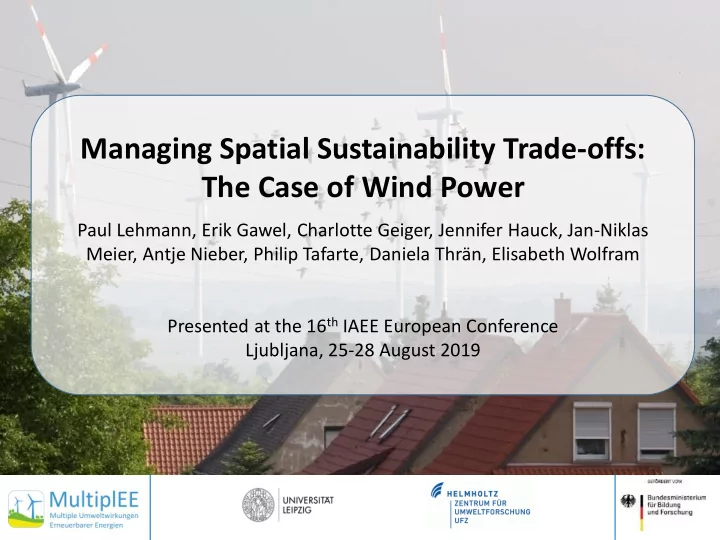

Managing Spatial Sustainability Trade-offs: The Case of Wind Power Paul Lehmann, Erik Gawel, Charlotte Geiger, Jennifer Hauck, Jan-Niklas Meier, Antje Nieber, Philip Tafarte, Daniela Thrän, Elisabeth Wolfram Presented at the 16 th IAEE European Conference Ljubljana, 25-28 August 2019
Content Introduction Method Results Discussion 2
Spatial allocation of wind power Differing opinions on where to site expanding number of wind turbines in Germany Underlying spatial trade-offs between ? different sustainability criteria, e.g., Minimization of power production ? costs Minimization of power grid and system integration costs Nature and landscape conservation Distributive justice 3
Research objectives Main research question: Which challenges arise for decision-making if wind power generation capacity has to be allocated across regions in the presence of sustainability trade-offs? Underlying questions: Is there a generally accepted ranking and definition of sustainability criteria? What is the relative importance of efficiency and equity arguments? 4
Literature review Economic analyses E.g., Eriksen et al., 2017, Klein et al., 2017, Kopiske and Gerhard, 2018, Schlachtberger et al., 2017 Focus on spatial optimization across different categories of energy system costs, no non-marketable sustainability criteria Multi-criteria decision analyses E.g., Egli et al., 2017; Eichhorn et al., 2019; Eichhorn et al., 2017, Kienast et al., 2017, Hanssen et al., 2018 More comprehensive consideration of sustainability criteria but very rigid assumptions regarding criteria weights Open question: How to rank sustainability criteria? 5
Content Introduction Method Results Discussion 6
Method: Simulation Game Transdisciplinary game to reveal preferences regarding sustainability criteria Played with 30 stakeholders from administration, industry, civil society, science, and intermediary organizations during a workshop Participants diveded into five groups with the different expertise being equally represented in each group 7
Method: Simulation game Wind yield Ecological risk of conflict Federal state‘s potential capacity for onshore wind power in GW Spatial load proximity Distributional justice Deploy 200 TWh onshore wind energy among the german federal states in 2030 8
Analysis of criteria ranking Sources for evaluation Self-reported group ranking of sustainability criteria Transcribed group discussions Correlation of quantitative group results with hypothetical allocations that are based on single criteria Group 1 1,0 Index of the relative importance of wind power development considering... Wind yield 0,8 Spatial load proximity 0,6 Nature and landscape conservation 0,4 Potential capacity Group 1 0,2 0,0 SH - HH MV NI - HB BB - BE ST NW SN TH HE RP - SL BY BW 9
Content Introduction Method Results Discussion 10
Allocation of wind power expansion over the five groups 11
Ranking of sustainability criteria I Group 1 Group 1 Group 1 and 2 1,0 1,0 1,0 Index of the relative importance of wind Index of the relative importance of wind Index of the relative importance of wind power development considering... power development considering... Wind yield Wind yield power development considering... Group 2 0,8 0,8 0,8 Spatial load proximity Spatial load proximity Spatial load proximity 0,6 0,6 0,6 Nature and landscape Nature and landscape Nature and landscape conservation conservation conservation 0,4 0,4 Potential capacity Potential capacity 0,4 Leistungspotential Group 1 Group 1 Group 1 0,2 0,2 0,2 0,0 0,0 0,0 SH - HH SH - HH MV MV NI - HB NI - HB BB - BE BB - BE ST ST NW NW SN SN TH TH HE HE RP - SL RP - SL BY BY BW BW SH - HH MV NI - HB BB - BE ST NW SN TH HE RP - SL BY BW 12
Ranking of sustainability criteria II Different weights for the four criteria eventuate in different spatial allocations of wind power among states Dominance of the trade-off between minimization of power production cost and minimization of grid and system integration cost Equal-distribution approach for all groups, but different concepts of equity Weak consideration of nature and landscape conservation criterion 13
Content Introduction Method Results Discussion 14
Implications for modelling Results of conventional multi-criteria decision analyses aggregating over multiple sustainability criteria not very reliable (primarily useful as tools for practitioners) Important for future research: More trade-off analyses comparing different mono-criterion optimizations in a consistent framework Identification of robust „ no-regret sites “ drawn in any mono - criterion optimization 15
Implications for policy-making Minimum requirement: transparency of criteria ranking underlying political decisions on wind power allocation Societal consensus needed regarding which criteria should matter more or less for the spatial allocation of wind power Participation of all relevant stakeholders in policy-making: Multi-level governance and participatory decision-making Critical revision of developments to centralize decisions and to allocate more competencies to executive and judiciary branches of government 16
Thank you for your kind attention! Paul Lehmann lehmann@wifa.uni-leipzig.de Junior Research Group MultiplEE https://home.uni-leipzig.de/multiplee Follow us on Twitter: @pleh_mann
Recommend
More recommend